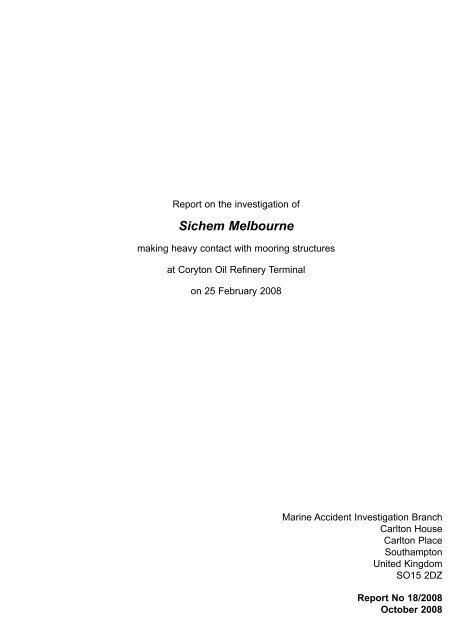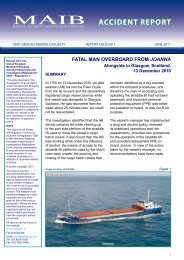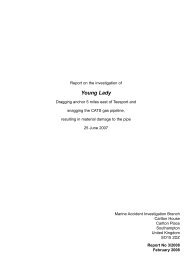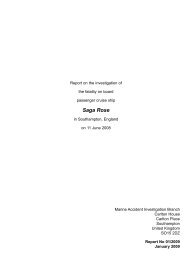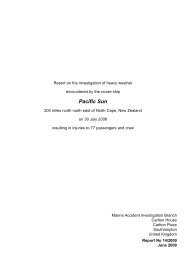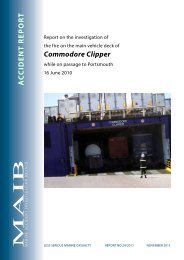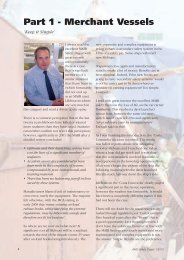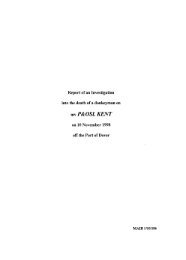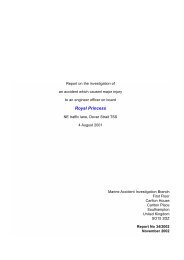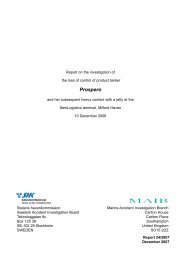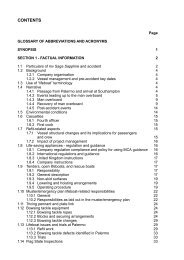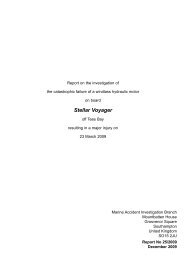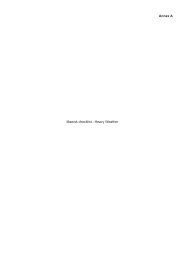Sichem Melbourne - Marine Accident Investigation Branch
Sichem Melbourne - Marine Accident Investigation Branch
Sichem Melbourne - Marine Accident Investigation Branch
Create successful ePaper yourself
Turn your PDF publications into a flip-book with our unique Google optimized e-Paper software.
Report on the investigation of<br />
<strong>Sichem</strong> <strong>Melbourne</strong><br />
making heavy contact with mooring structures<br />
at Coryton Oil Refinery Terminal<br />
on 25 February 2008<br />
<strong>Marine</strong> <strong>Accident</strong> <strong>Investigation</strong> <strong>Branch</strong><br />
Carlton House<br />
Carlton Place<br />
Southampton<br />
United Kingdom<br />
SO15 2DZ<br />
Report No 18/2008<br />
October 2008
Extract from<br />
The United Kingdom Merchant Shipping<br />
(<strong>Accident</strong> Reporting and <strong>Investigation</strong>)<br />
Regulations 2005 – Regulation 5:<br />
“The sole objective of the investigation of an accident under the Merchant Shipping (<strong>Accident</strong><br />
Reporting and <strong>Investigation</strong>) Regulations 2005 shall be the prevention of future accidents<br />
through the ascertainment of its causes and circumstances. It shall not be the purpose of an<br />
investigation to determine liability nor, except so far as is necessary to achieve its objective, to<br />
apportion blame.”<br />
NOTE<br />
This report is not written with litigation in mind and, pursuant to Regulation 13(9) of the<br />
Merchant Shipping (<strong>Accident</strong> Reporting and <strong>Investigation</strong>) Regulations 2005, shall be<br />
inadmissible in any judicial proceedings whose purpose, or one of whose purposes is to<br />
attribute or apportion liability or blame.<br />
Further printed copies can be obtained via our postal address, or alternatively by:<br />
Email: maib@dft.gsi.gov.uk<br />
Tel: 023 8039 5500<br />
Fax: 023 8023 2459<br />
All reports can also be found on our website:<br />
www.maib.gov.uk
CONTENTS Page<br />
GLOSSARY OF ABBREVIATIONS AND ACRONYMS<br />
SYNOPSIS 1<br />
SECTION 1 - FACTUAL INFORMATION 2<br />
1.1 Particulars of <strong>Sichem</strong> <strong>Melbourne</strong> and accident 2<br />
1.2 Narrative 3<br />
1.2.1 Environmental conditions 3<br />
1.2.2 Events leading to the accident 3<br />
1.2.3 Post-accident 6<br />
1.3 <strong>Sichem</strong> <strong>Melbourne</strong> 11<br />
1.4 Vessel management 11<br />
1.5 Master 11<br />
1.6 Bridge manning 12<br />
1.7 Port of London Authority 12<br />
1.7.1 Pilotage 14<br />
1.7.2 Pilot training 16<br />
1.7.3 Pilot 16<br />
1.8 Petroplus 16<br />
SECTION 2 - ANALYSIS 19<br />
2.1 Aim 19<br />
2.2 Cause of the accident 19<br />
2.3 Pilotage 19<br />
2.4 Master / pilot exchange of information 20<br />
2.5 Communications 20<br />
2.6 Thruster control positioning 21<br />
2.7 Engine failure 21<br />
2.8 Petroplus 22<br />
2.9 Use of tugs 22<br />
2.10 Tide 22<br />
2.11 Fatigue 22<br />
2.12 Similar accidents 22<br />
SECTION 3 - CONCLUSIONS 24<br />
3.1 Safety issues 24<br />
3.2 Safety issues directly contributing to the accident which have<br />
resulted in recommendations 24<br />
3.3 Safety issues identified during the investigation which have<br />
not resulted in recommendations but have been addressed 24<br />
SECTION 4 - ACTION TAKEN 25<br />
4.1 Actions taken by EMS ship management (India) PVT. Ltd. 25<br />
4.2 Actions taken by Petroplus 25<br />
4.3 Actions taken by Port of London Authority 25<br />
4.4 MAIB 25<br />
SECTION 5 - RECOMMENDATIONS 26
GLOSSARY OF ABBREVIATIONS AND ACRONYMS<br />
AB - Able Bodied Seaman<br />
AIS - Automatic Identification System<br />
BPM - Bridge Procedures Manual<br />
BTM - Bridge Team Management<br />
Cable - 0.1 nautical mile<br />
CDI - Chemical Distribution Institute<br />
CHA - Competent Harbour Authority<br />
DfT - Department for Transport<br />
DNV - Det Norske Veritas<br />
EMS - Eitzen Maritime Services<br />
Head down - Facing downstream towards the sea<br />
ICS - International Chamber of Shipping<br />
IMO - International Maritime Organization<br />
ISM - International Management Code for the Safe Operation of Ship<br />
and for Pollution Prevention<br />
kts - knots<br />
kW - kilowatt<br />
LNG - Liquefied Natural Gas<br />
LPG - Liquefied Petroleum Gas<br />
m - metre<br />
No - Number<br />
OCIMF - Oil Companies International <strong>Marine</strong> Forum<br />
PLA - Port of London Authority<br />
PLVTS - Port of London Vessel Traffic Services<br />
PMSC - Port <strong>Marine</strong> Safety Code<br />
POAP - Pilots’ Operational Advisory Panel
SIRE - Ship Inspection Report<br />
SMS - Safety Management System<br />
S-VDR - Simplified Voyage Data Recorder<br />
UK - United Kingdom<br />
USCG - United States Coast Guard<br />
UTC - Universal Co-ordinated Time<br />
VDR - Voyage Data Recorder<br />
VHF - Very High Frequency<br />
VTS - Vessel Traffic Services<br />
All times used in this report are UTC unless otherwise stated
Figure 1<br />
<strong>Sichem</strong> <strong>Melbourne</strong>
SYNOPSIS<br />
On the evening of 25 February 2008 the product carrier, <strong>Sichem</strong><br />
<strong>Melbourne</strong>, sustained damage and damaged mooring structures as<br />
she departed her berth at Coryton Oil Refinery on the River Thames<br />
estuary. Fortunately, her broadside contact with a mooring dolphin<br />
prevented <strong>Sichem</strong> <strong>Melbourne</strong> from striking an oil tanker which was<br />
discharging on a neighbouring jetty.<br />
At departure, <strong>Sichem</strong> <strong>Melbourne</strong> was laying port side to Coryton<br />
Number 3 jetty, heading downstream, stern towards the last of the<br />
ebb tide, with a light wind onto the ship’s starboard quarter. A Port of London Authority (PLA)<br />
pilot boarded to conduct the navigation of the vessel during the departure. Following a brief<br />
exchange between the vessel’s master and the pilot, the vessel’s moorings were singled<br />
up. The pilot made a comment to the master that an hour of ebb tide remained and that,<br />
consequently, they should use the bow spring in letting go. The pilot did not fully explain how<br />
he intended to move the vessel clear of the jetty.<br />
The pilot, who was stationed on the port bridge wing with the master, gave instructions to<br />
come ahead on the forward springs with hard port rudder, with the intention of creating a<br />
“wedge” of water between the ship and jetty, before coming astern into the river and current.<br />
When an angle of about 7º had developed between the ship’s stern and the jetty, the master<br />
applied bow thrust to starboard to prevent her bow leaning against the jetty. Soon after this<br />
the bow spring was cast off before the pilot was ready, allowing the ship to move forward<br />
before the current. Combined effects of increased starboard bow thrust and wind on the<br />
starboard quarter caused the ship’s port quarter to fall back and scour the jetty before she<br />
cleared the structure. Once clear of the jetty the pilot attempted to retrieve his original plan<br />
of getting the stern outwards by applying port wheel and more ahead power. The master,<br />
however, was under the impression that the pilot was trying to lift the vessel bodily into the<br />
river, and applied more starboard thrust to assist. The following tidal stream prevented<br />
transverse lifting of the ship and she was carried down onto other mooring structures.<br />
During attempts to recover the situation, numerous, rapid, ahead/astern movements were<br />
placed on the main engine, resulting in the engine’s safety management system shutting down<br />
the main engine. Fortunately, the engine was quickly restarted, allowing the vessel to clear a<br />
tanker which was berthed on an adjoining jetty.<br />
<strong>Sichem</strong> <strong>Melbourne</strong> was diverted to Southend anchorage where she was inspected for damage<br />
by a classification society surveyor, before being allowed to sail.<br />
The MAIB investigation identified contributing factors to the accident:<br />
• There was an inadequate exchange of information between master and pilot before<br />
commencing unmooring operations.<br />
•<br />
•<br />
Interaction and communications between members of the bridge team were poor.<br />
Much of the conversation between the crew was conducted in the Russian language.<br />
This effectively excluded the pilot from the bridge team.<br />
Recommendations have been made to all UK Competent Harbour Authorities, and EMS<br />
Ship Management (India) Pvt. Ltd, with the aim of improving: port procedures; pilot/master<br />
interaction; bridge team management and pilot monitoring. A recommendation has also been<br />
made to the terminal operator regarding its marine risk assessment.<br />
1
SECTION 1<br />
2<br />
- FACTUAL INFORMATION<br />
1.1 PARTICULARS OF SicheM <strong>Melbourne</strong> (FIGURE 1) AND ACCIDENT<br />
Vessel details<br />
Registered owner : Eitzen Chemical Singapore Pte<br />
Manager(s) : Eitzen Maritime Services, Ship Management<br />
(India) Pvt. Ltd<br />
Port of registry : Singapore<br />
Flag : Singapore<br />
Type : Type 2 Chemical/Product carrier<br />
Built : 2007, South Korea<br />
Classification society : Det Norske Veritas<br />
Construction : Welded steel, double hull<br />
Length overall : 127.2m<br />
Gross tonnage : 8,455<br />
Engine power and/or type : 4440kW. STX-B&W 6S35MC<br />
Service speed : 12.4kts<br />
Other relevant info : Fixed pitch, right handed propeller;<br />
402kW bow thruster; semi balanced rudder<br />
<strong>Accident</strong> details<br />
Time and date : 25 February 2008, 2015<br />
Location of incident : Coryton Oil Refinery, River Thames<br />
Persons on board : 19<br />
Injuries/fatalities : None<br />
Damage : Damage to vessel shell plating, frames and rails;<br />
damage to jetty and mooring dolphins.
1.2<br />
1.2.1<br />
1.2.2<br />
NARRATIVE<br />
Much of the information in this report is derived from analysis of data retrieved from<br />
<strong>Sichem</strong> <strong>Melbourne</strong>’s Simplified Voyage Data Recorder (S-VDR).<br />
Environmental conditions<br />
• Dark<br />
•<br />
•<br />
•<br />
•<br />
•<br />
Wind: SW, Beaufort force 4<br />
Sea state, smooth<br />
Good visibility<br />
Spring tide +2 days; 1 hour before low water<br />
Approximately ½ to 1 knot easterly setting tidal stream, parallel to jetty 3.<br />
Events leading to the accident<br />
<strong>Sichem</strong> <strong>Melbourne</strong> completed the discharge of a cargo of gas oil at Coryton refinery<br />
during the evening of 25 February 2008. Arrangements were then made for the vessel<br />
to sail from the terminal’s No 3 berth, where she was lying port side to and heading<br />
downstream, for the NE Spit anchorage at the entrance to the River Thames.<br />
A PLA pilot boarded the ship at 1951 and proceeded to the bridge, where he met the<br />
master some 6 minutes later. During the initial discussions between the pilot and the<br />
master it was revealed that the latter thought that <strong>Sichem</strong> <strong>Melbourne</strong> was to proceed to<br />
the Sunk anchorage rather than the NE Spit anchorage. The discrepancy was clarified<br />
and it was agreed that the vessel would proceed to the NE Spit anchorage.<br />
A master and pilot exchange of information was carried out; this included pilot card<br />
items, draft confirmation, and questioning whether the vessel was similar to her sister<br />
ship, <strong>Sichem</strong> Edinburgh, which the pilot was familiar with. Both pilot and master had<br />
prepared passage plans covering the departure operation, however at no time were<br />
these compared or discussed. The pilot advised the master that, as an ebb tide was<br />
running, care would be needed when releasing the stern lines (just in case they were<br />
carried into the propeller by the tidal stream). The master asked which would be the<br />
last line to let go; the pilot advised it would be the forward spring.<br />
The chief officer explained to the pilot that the vessel’s automatic identification system<br />
(AIS) had suffered antennae damage on her inward voyage, and that a new one was<br />
now fitted, but that he was not sure if it was working properly. All pre-departure checks<br />
of engines and equipment were carried out, and the master informed the pilot that all<br />
was well and, specifically, that the bow thruster was working.<br />
As the vessel was facing downstream, port side to, the pilot’s intention was to come<br />
ahead on the forward springs and allow a substantial wedge of water to form between<br />
the ship’s stern and the jetty, putting the south westerly wind dead astern or fine on the<br />
port quarter. At this point he planned to let go the springs and bring the vessel astern<br />
into the channel. The plan to bring the vessel astern, however, was not discussed<br />
or shared with the master because the pilot felt it was self-explanatory. The master<br />
believed that, as there was only an hour of ebb tide to run, the stream would be fairly<br />
slack and that they would sail out ahead, away from the berth, on a course of 139˚, as<br />
3
4<br />
indicated on his passage plan (Annex 1). Had the stream been stronger, he believed<br />
that tug assistance would have been required. Again, this was not discussed with the<br />
pilot.<br />
During the departure operation, the master and pilot were both stationed on the port<br />
bridge wing. After receiving clearance to sail from the Port of London Vessel Traffic<br />
Services (PLVTS), the mooring ropes were singled up and then cast off; leaving only the<br />
forward springs attached. At 2018, the pilot ordered the wheel to be placed hard to port<br />
and the engines on dead slow ahead. Some 30 seconds later the master engaged the<br />
bow thruster with 50% power to starboard, thus preventing the ship’s bow from pressing<br />
against the jetty. The master was positioned so that his body shielded the thruster<br />
controls from the pilot’s vision; however this first thruster manoeuvre was done with the<br />
knowledge of the pilot, who was not particularly in favour of it, but passed no comment.<br />
Two minutes later, with an angle of less than 7º between the ship and jetty, the pilot<br />
requested the engine to be stopped due both to the strain on the remaining ropes and<br />
to evaluate the ship’s positioning. The angle between the ship and jetty increased<br />
slightly and it was the master’s understanding that the pilot was now ready to let go, and<br />
therefore ordered, in Russian, the forward springs to be cast off and simultaneously gave<br />
full bow thrust to starboard. Because the order was given in Russian, the pilot was not<br />
aware the remaining ropes to the jetty were being released until they had been let go.<br />
But he still made no comment to the master. The wind was still on the starboard quarter<br />
at this time and this, combined with the effect of the increased bow thruster caused the<br />
ship’s port quarter to move towards the jetty as the vessel gathered way. The pilot was<br />
concerned at the early release of the ropes but felt that he could retrieve the situation by<br />
moving the ship’s head to port and then coming astern into the channel. However, this<br />
intention was not communicated to the master, who continued to operate the vessel’s<br />
bow thruster on full power to starboard in an attempt to avoid contact of the bow with the<br />
forward mooring dolphin. Consequently, <strong>Sichem</strong> <strong>Melbourne</strong>’s port quarter scraped the<br />
face of the jetty as the ship moved ahead.<br />
The pilot made an attempt to stop the ship’s forward movement by giving instructions to<br />
come astern, however this resulted in transverse thrust from the right handed propeller<br />
setting the ship towards the shore and mooring dolphin MD35 (Figure 2). On seeing<br />
this, the pilot requested that the engines were put half ahead, and the helm hard aport<br />
in a further attempt to pivot <strong>Sichem</strong> <strong>Melbourne</strong> clear of the dolphin and move her stern<br />
towards the channel; this was thwarted by the master once more applying starboard<br />
bow thrust without the pilot’s knowledge. Consequently the ship made contact with the<br />
dolphin MD35.<br />
Jetty 3’s supervisor observed <strong>Sichem</strong> <strong>Melbourne</strong>’s departure and erratic manoeuvres,<br />
and called, using VHF radio, firstly the ship and then the harbourmaster’s launch, to<br />
advise that <strong>Sichem</strong> <strong>Melbourne</strong> had hit the dolphin. He also warned that there was<br />
a danger that she may experience further problems, and requested tug assistance.<br />
Unfortunately this transmission was lost due to both parties speaking on the radio<br />
simultaneously. The transmission did, however, alert berthing and workboat staff on jetty<br />
1 (Figure 2), who then observed the wayward ship and evacuated the structure as she<br />
bore down on them.
Reproduced from Admiralty Chart BA 1186 by permission of<br />
the Controller of HMSO and the UK Hydrographic Office.<br />
Jetty no.1<br />
Jetty no.3<br />
Jetty no.4<br />
MD41<br />
MD35<br />
Thornbury<br />
Track of <strong>Sichem</strong> <strong>Melbourne</strong><br />
Figure 2<br />
Modified chart showing berths at Coryton Refinery<br />
5
1.2.3<br />
6<br />
The pilot decided to regain control of the situation by laying <strong>Sichem</strong> <strong>Melbourne</strong><br />
alongside the empty jetty 1 (which frequently berths liquefied petroleum gas (LPG)<br />
carriers) and then get tugs to pull her clear, but he did not communicate this plan to<br />
the master. The master, on seeing <strong>Sichem</strong> <strong>Melbourne</strong> moving towards jetty 1, took<br />
command and forcefully steered the vessel clear of jetty 1 with the use of engine,<br />
rudder and thruster manoeuvres. However, this placed the vessel in danger of being<br />
carried broadside towards the causeway and pipe line carrying oil from the tanker<br />
Thornbury, discharging on jetty 4 (Figure 2). A rapid series of full ahead / full astern<br />
manoeuvres then took place, with the master and pilot countermanding each other’s<br />
orders at one point until, at 2029.40, the main engine’s safety management system cut<br />
in and shut the engine down. The ship still had some 3.5kts of way on her at this point<br />
and she landed heavily on the mooring dolphin MD41 (Figure 2), which held the stern<br />
lines for Thornbury, displacing the supporting legs of the dolphin. On notification of the<br />
engine failure, the pilot immediately requested tug assistance via PLVTS, and the duty<br />
tug, Castlepoint, was dispatched from her station nearby.<br />
The chief engineer succeeded in quickly resetting the engine and regaining power,<br />
allowing <strong>Sichem</strong> <strong>Melbourne</strong> to clear Thornbury’s stern by a very small margin and pass<br />
into the main channel.<br />
Post-accident<br />
The pilot notified PLVTS that engine power in <strong>Sichem</strong> <strong>Melbourne</strong> had been restored<br />
and the vessel was proceeding downstream. He then contacted the duty port controller<br />
and told him of the incident and cancelled his previous request for tug assistance. The<br />
duty port controller advised the pilot to take the ship to nearby Southend anchorage<br />
until it could be established what damage had been done to the vessel and the jetty<br />
structures.<br />
As the mooring structure holding Thornbury’s stern line had been damaged, discharge<br />
was suspended and the tug Stanford was dispatched to push against her stern as a<br />
precautionary measure, until the dolphin could be properly inspected for damage.<br />
With <strong>Sichem</strong> <strong>Melbourne</strong> proceeding towards the anchorage, the ship’s damage control<br />
party established that she had not sustained serious damage and the master notified<br />
his managers, EMS Ship Management, India, of the accident. <strong>Sichem</strong> <strong>Melbourne</strong><br />
anchored safely at Southend without further incident.<br />
At daylight the next morning the full extent of the damage to both ship (Figures 3a,<br />
b, c, d) and mooring structures (Figures 4a, b, c, d) was established. The mooring<br />
dolphins were inspected by divers for foundation damage, and were deemed secure.<br />
Temporary repairs were carried out above water and the dolphins were declared sound<br />
enough to attach ropes to, and safe for personnel.<br />
Following an inspection of <strong>Sichem</strong> <strong>Melbourne</strong>’s main engine controls and hull damage<br />
by a surveyor from the ship’s classification society, Det Norske Veritas (DNV), the<br />
ship was allowed to sail, in ballast, to a repair yard. Her full term Safety Construction<br />
Certificate was withdrawn and a short term certificate, valid for 6 days, was issued in<br />
its place. No deficiencies were found with the engine control system and the ship’s<br />
manager made arrangements for hull repairs to be carried out.
Damage to <strong>Sichem</strong> <strong>Melbourne</strong>’s sheer strake and deck edge<br />
Deck edge damage<br />
Figure 3a<br />
Figure 3b<br />
7
8<br />
Rail damage<br />
Hole in deck<br />
Figure 3d<br />
Figure 3c
Damage to MD 41 mooring structure and stern lines leading to Thornbury<br />
Damage to MD 41 mooring structure and stern lines leading to Thornbury<br />
Figure 4a<br />
Figure 4b<br />
9
10<br />
Damage to MD 41 mooring structure<br />
Damage to MD 41 mooring structure<br />
Figure 4c<br />
Figure 4d
1.3 SicheM <strong>Melbourne</strong><br />
1.4<br />
1.5<br />
<strong>Sichem</strong> <strong>Melbourne</strong> was delivered by her builders in late July 2007. She was owned<br />
by Eitzen Chemical (Singapore) Pte Ltd and managed by EMS Ship Management<br />
(India) Pvt. Ltd. The vessel was on spot charter to Trafigura Beheer BV at the time of<br />
the accident, having just delivered a cargo of gas oil from Brofjorden, Norway, to the<br />
Petroplus refinery. Following her departure from Coryton, she was to await orders for<br />
her onward destination.<br />
In the previous months, <strong>Sichem</strong> <strong>Melbourne</strong> had been chartered to various major oil<br />
companies including Shell, Statoil Hydro and BP, trading regularly between Europe<br />
and Canada. These companies all belong to the Oil Companies International <strong>Marine</strong><br />
Forum (OCIMF) and had carried out stringent validation of <strong>Sichem</strong> <strong>Melbourne</strong> through<br />
OCIMF’s Ship Inspection Report Programme (SIRE) for the carriage of petrochemicals.<br />
At the time of the accident <strong>Sichem</strong> <strong>Melbourne</strong> held approval from: Shell; BP; Statoil<br />
Hydro; and Repsol for the carriage of their cargoes. Additionally, she held approvals<br />
from Chemical Distribution Institute (CDI) and the United States Coast Guard (USCG).<br />
<strong>Sichem</strong> <strong>Melbourne</strong> had a safe manning certificate for 12, but carried a crew of 18. This<br />
increased crewing allowed officers to work a routine of 4 hours “on duty” followed by<br />
8 hours “off.” The official language on board all EMS ships was English; the working<br />
language on <strong>Sichem</strong> <strong>Melbourne</strong>, however, was Russian, as the crew were a mix of<br />
Ukrainian, Russian and Latvian nationalities.<br />
The vessel was equipped with a JRC S-VDR. This recorded much of the vessel’s<br />
activities including: helm, engine, bow thrust and speech data.<br />
<strong>Sichem</strong> <strong>Melbourne</strong> was fitted with a single-acting reversible crosshead main engine.<br />
At full sea speed, the time required to reverse the engine from full ahead to full astern<br />
was approximately 326 seconds. The engine had a standard management system<br />
designed to protect it from excessive rapid ahead and astern demands. During the<br />
accident, the management system functioned appropriately and shut the engine down.<br />
VESSEL MANAGEMENT<br />
The managers of <strong>Sichem</strong> <strong>Melbourne</strong> provided a full management service, including<br />
crewing and technical operation, for 22 ships belonging to Eitzen Chemicals<br />
(Singapore) Pte. Ltd. The managers held a valid ISM Code Document of Compliance<br />
issued by Det Norske Veritas on behalf of the Republic of Singapore, for the operation<br />
of bulk carriers, oil tankers and chemical tankers.<br />
An audit by DNV 12 weeks before the accident confirmed that <strong>Sichem</strong> <strong>Melbourne</strong>’s<br />
SMS complied with the ISM Code, and a Safety Management Certificate valid for<br />
5 years had been issued. The SMS incorporated a ship operations manual, which<br />
detailed the company’s requirement for port departure procedures (Annex 2).<br />
MASTER<br />
The master’s career spanned 21 years at sea, qualifying as deep sea master in 2001 at<br />
Kiev, Ukraine. He had worked for EMS (through various management name changes)<br />
for 10 years; 5 years of that as chief officer and 5 years as master on chemical tankers.<br />
He held a Singaporean endorsement to his masters’ certificate. As part of his training,<br />
the master had attended Bridge Team and Resource Management training in 2001 and<br />
Ship Handling by bridge simulator in 2006.<br />
11
1.6<br />
1.7<br />
12<br />
The master was half way through a 4-month contract on board <strong>Sichem</strong> <strong>Melbourne</strong>, and<br />
had previous experience on the sister ships <strong>Sichem</strong> Rio and <strong>Sichem</strong> New York. He<br />
had visited Coryton about 20 times before as chief officer on various vessels. On the<br />
majority of those occasions, the vessel had sailed from her berth head to tide. This was<br />
the master’s first time at Coryton as master of a vessel.<br />
BRIDGE MANNING<br />
At the time of the accident, the bridge was manned by the master, pilot, chief officer and<br />
a helmsman. The chief officer and helmsman were positioned by the bridge telegraph<br />
and helm respectively, while the pilot and master were stationed on the bridge wing with<br />
the master in position to control the bow thrusters (Figures 5a, b). The bow thruster<br />
control was placed in a convenient position for operation on the bridge wing, but the<br />
pilot’s view of this was obscured by the master’s body.<br />
Communications to the bridge control stations and mooring parties were given by<br />
radio from the master, with the relevant instructions repeated by the chief officer and<br />
helmsman before applying them.<br />
PORT OF LONDON AUThORITY<br />
As a self-funding public trust, PLA is the competent authority with statutory responsibility<br />
for conservancy and navigational regulation on 94 miles of the tidal River Thames. As<br />
well as pilotage, the Authority provides navigational services for ships using the port,<br />
including the maintenance of shipping channels, moorings, lights and buoys.<br />
The PLA is a signatory to the Port <strong>Marine</strong> Safety Code (PMSC), a Department<br />
for Transport (DfT) code of practice for Competent Harbour Authorities (CHAs).<br />
Participation of the Code requires CHAs to maintain a navigational safety management<br />
system (SMS) based on formal risk assessment. The PLA risk assessment recognised<br />
the possibility of ships colliding with mooring structures within its waters, and pilotage,<br />
by trained experienced pilots, was one of its ultimate controls to reduce such<br />
happenings. An extract from the PLA risk assessment relating to mooring structure and<br />
moored ship contacts is at Annex 3.<br />
An integral part of the PLA SMS is its “Code of Practice for Ship Towage Operations on<br />
the Thames”; a voluntary code of good practice. Although tug assisted manoeuvring<br />
is voluntary, PLA does have the power to mandate tug assistance under its<br />
Harbourmaster’s Special Directions, which also incorporates pilots’ advice to masters to<br />
employ tug assistance, if deemed appropriate.<br />
PLA does not mandate tug assisted manoeuvring, however many of the berth owners<br />
and operators, including Petroplus, do. Where compulsory towage is required by berth<br />
owners/operators, the requirements are equivalent to, or in excess of, those proposed<br />
by the PLA towage Code of Practice.<br />
The PLA is a proactive member of all port operator safety committees and encourages<br />
operator involvement in issues of navigational safety. Authority representatives<br />
participate in Coryton terminal safety meetings, which convene every 2 months and are<br />
hosted by Petroplus.
Bridge wing and bow thruster control<br />
Detail of bow thruster control<br />
Figure 5b<br />
Figure 5a<br />
13
14<br />
The Authority also actively promotes a forum for its pilots, the Pilots’ Operational<br />
Advisory Panel (POAPs), where pilots’ representatives and management meet to<br />
discuss issues with a view to improving common goals. Additionally, a hazard review<br />
panel, comprising managers and pilots, meets on a two monthly basis where they<br />
frequently discuss issues taken forward by Navigation Advisory Panels, which may be<br />
formed following incidents on the river.<br />
PLA owns, in conjunction with HR Wallingford 1 , a sophisticated two dimensional tidal<br />
model, which gives detailed tidal predictions at various points on the River Thames; the<br />
predictions for Coryton at the time of the accident are shown in Figure 6. Observed<br />
tidal values and surge differences from the predicted datum are monitored at various<br />
points throughout the river; Figure 7 gives this information for Coryton, 2 hours before<br />
and after the incident. This indicates that the heights of tide, and therefore stream<br />
velocity at the time of the accident, to be very close to the predicted values.<br />
1.7.1 Pilotage<br />
The London Pilotage District stretches from Putney Bridge in the west to the Sunk pilot<br />
station in the east. At the time of the accident the PLA employed 90 pilots of varying<br />
proficiency and ability, including:<br />
• Twelve berthing pilots – specialist senior sea pilots retained for their experience<br />
of safely berthing and unberthing tankers of > 11,000GT or 160m in length.<br />
• Sixty six sea pilots, ranging from class 4 to class 1 pilots, responsible for<br />
navigating vessels safely from the outer pilot stations to inland as far as<br />
Crayfordness.<br />
• Twelve river pilots who specialise in the stretch of the river between Gravesend<br />
and London Bridge, three of whom are bridge pilots specialising in under bridge<br />
clearance from London Bridge to Putney Bridge.<br />
Compulsory pilotage is required for, among others: all specified vessels (vessels<br />
carrying explosives, flammables etc); vessels > 50m carrying marine pollutant in bulk,<br />
and vessels with an operating draught of 5m or more.<br />
PLA pilots work a 9 days “on”, 6 days “off” rota, with pilots moving to the bottom of the<br />
“turns list” after completing a “trip” or act of pilotage. This normally allowed no fewer<br />
than 8 hours off duty after an 8 hour “trip”, or 12 hours off after a 12 hour “trip” etc. The<br />
system allowed the Authority to service an average of 26 sea pilotage acts and 5 river<br />
acts daily.<br />
After being notified of a pending “trip,” pilots had the option of either attending the pilots’<br />
“ready room”, at PLA offices, to make preparations for their trip or, where a pilot had<br />
external internet access to POLARIS (the Port’s Ship Information System), they could<br />
join a ship directly from home. A fundamental part of a pilot’s preparation for a “trip”<br />
is the compiling of a Passage Plan. PLA had a house style Master/Pilot Information<br />
Exchange and Passage Plan (Annex 4), but did not insist on its use by their pilots;<br />
this plan had a section dedicated to manoeuvring and mooring. PLA allowed pilots to<br />
1 HR Wallingford: Independent research and consultancy experts in civil engineering and environmental<br />
hydraulics; formerly the Hydraulics Research Station of the UK Government.
1.00<br />
0.01<br />
0.18<br />
0.56<br />
1.13<br />
1.00<br />
1.00<br />
1.00<br />
0.15<br />
1.33<br />
0.18<br />
1.00<br />
1.00<br />
0.00<br />
Figures 6 and 7 courtesy of the<br />
Port of London Authority (PLA)<br />
1.00<br />
0.94<br />
1.15<br />
0.14<br />
1.00<br />
1.00<br />
1.00<br />
0.06<br />
0.42<br />
0.99<br />
1.15<br />
1.00<br />
0.02<br />
0.09<br />
0.73<br />
No.5<br />
Tide<br />
Gauge<br />
1.11<br />
1.21<br />
0.07<br />
0.22<br />
Spring Tide Flows hw Southend +5hrs<br />
Rate in Knots<br />
0.34<br />
1.02<br />
1.20<br />
CORYTON<br />
0.29<br />
1.00<br />
0.27<br />
0.88<br />
1.21<br />
1.24<br />
0.23<br />
0.01<br />
0.23<br />
0.72<br />
1.28 1.17<br />
1.27<br />
1.00<br />
1.16<br />
1.13<br />
1.11 1.15<br />
1.16<br />
1.17<br />
1.20<br />
0.16<br />
1.00<br />
0.54<br />
1.20<br />
1.28<br />
0.03<br />
Position Date and time Observed tide (m) Difference to prediction (m)<br />
CORYTON 25/02/2008 18:30 2.73 -0.02<br />
CORYTON 25/02/2008 18:40 2.53 0.00<br />
CORYTON 25/02/2008 18:50 2.34 0.01<br />
CORYTON 25/02/2008 19:00 2.16 0.02<br />
CORYTON 25/02/2008 19:10 1.98 0.02<br />
CORYTON 25/02/2008 19:20 1.81 0.01<br />
CORYTON 25/02/2008 19:30 1.66 0.01<br />
CORYTON 25/02/2008 19:40 1.52 0.00<br />
CORYTON 25/02/2008 19:50 1.40 0.00<br />
CORYTON 25/02/2008 20:00 1.29 0.00<br />
CORYTON 25/02/2008 20:10 1.21 0.00<br />
CORYTON 25/02/2008 20:20 1.14 0.01<br />
CORYTON 25/02/2008 20:30 1.07 0.01<br />
CORYTON 25/02/2008 20:40 1.02 0.01<br />
CORYTON 25/02/2008 20:50 0.98 0.01<br />
CORYTON 25/02/2008 21:00 0.94 0.00<br />
CORYTON 25/02/2008 21:10 0.91 -0.01<br />
CORYTON 25/02/2008 21:20 0.89 -0.03<br />
CORYTON 25/02/2008 21:30 0.88 -0.05<br />
CORYTON 25/02/2008 21:40 0.88 -0.07<br />
CORYTON 25/02/2008 21:50 0.90 -0.09<br />
CORYTON 25/02/2008 22:00 0.94 -0.11<br />
CORYTON 25/02/2008 22:10 1.00 -0.13<br />
CORYTON 25/02/2008 22:20 1.08 -0.15<br />
CORYTON 25/02/2008 22:30 1.19 -0.16<br />
0.01<br />
0.43<br />
0.88<br />
1.22<br />
1.29<br />
129 No.2<br />
0.07<br />
No.3<br />
0.06<br />
Observed heights of tide 2 hours before and after the accident<br />
0.70<br />
1.03<br />
0.04<br />
0.07<br />
1.16<br />
1.19<br />
0.05<br />
0.57<br />
0.98<br />
1.15<br />
1.24<br />
1.00<br />
0.46<br />
0.24Dn<br />
0.84<br />
1.08<br />
1.14<br />
Predicted tide rates at time of accident<br />
1.24<br />
Horseshoe<br />
Bay<br />
1.00<br />
0.70<br />
1.00<br />
1.12<br />
0.10<br />
1.17<br />
1.00<br />
0.48<br />
0.89<br />
1.12<br />
1.14<br />
1.22<br />
1.21<br />
0.11<br />
0.05<br />
No.1<br />
1.19<br />
0.05<br />
0.85<br />
1.03<br />
0.33<br />
1.16<br />
1.00<br />
1.00<br />
1.01<br />
1.07<br />
1.13<br />
Figure 7<br />
Figure 6<br />
1.00<br />
0.28<br />
0.60<br />
1.17<br />
1.12<br />
0.07<br />
1.16<br />
1.00<br />
1.20<br />
0.93<br />
1.18<br />
1.00<br />
0.61<br />
15<br />
0.10<br />
1.11<br />
1.00<br />
0.09<br />
1.31<br />
0.40<br />
1.10<br />
1.31<br />
1.00<br />
0.22<br />
0.69<br />
0.97
1.7.2<br />
1.7.3<br />
1.8<br />
16<br />
produce their own passage plan, provided it was kept for a period of at least 3 months<br />
after the pilotage “trip.” <strong>Sichem</strong> <strong>Melbourne</strong>’s pilot did not use the PLA house style<br />
Passage Plan document, but did use a plan of his own making.<br />
Pilot training<br />
All PLA pilots hold STCW Class 1 Master’s Certificates of Competency gained during<br />
statutory sea service. Upon employment with the Authority, pilots are given 6 months<br />
training, which includes shadowing experienced pilots and supervised ship, river and<br />
berth familiarisation. On completion of their training, pilots are assessed and examined<br />
before being authorised to operate un-chaperoned at designated levels of between<br />
Class 42 and Class 1, dependent on vessel length, and draught. When pilots wish to<br />
progress from a lower to a higher class, they are again supervised and assessed by<br />
a senior pilot. The PLA does not operate any system of regular pilot appraisal after<br />
they have gained authorisation to their class status, other than ship handling and<br />
manoeuvring on their in house bridge simulator.<br />
PLA acquired its own state of the art ship’s bridge simulator in 2003; it is housed in<br />
its Gravesend offices. The simulator was purchased to allow the Authority to train its<br />
pilots with realistic simulation of their own river, and replicates exactly, conditions of the<br />
River Thames. Simulation exercises are followed by peer review, however they do not<br />
include any form of Bridge Team Management (BTM) training or reference to master/<br />
pilot interaction.<br />
Coincidentally, PLA started training its pilots in BTM at an external training centre<br />
6 days after this accident. The training had been organised several months before<br />
the accident and involves sending groups comprising the same class of pilots to the<br />
training centre at the same time.<br />
Pilot<br />
The pilot had been employed by PLA for 10 years, during which time he progressed<br />
through the ranks from a Class 4 pilot to a Class 1, unrestricted sea pilot, in 2001. This<br />
qualification authorised him to carry out pilotage acts on any vessel plying between the<br />
Sunk pilotage and Crayfordness. After obtaining his Class 1 Masters certificate, he<br />
had sailed as chief officer on various ships, but never as master. Throughout his time<br />
at PLA the pilot had carried out 1240 acts of pilotage, with over 100 of those from the<br />
Coryton refinery jetties; he had not been involved in any previous accidents and was<br />
highly regarded by the PLA and colleagues.<br />
The pilot had attended a 5 day BTM training course at <strong>Marine</strong> International Safety,<br />
Rotterdam BV, 13 years previously, and had twice received 3 days ship handling<br />
training in the PLA ship’s bridge simulator. <strong>Sichem</strong> <strong>Melbourne</strong> was to be his first act of<br />
pilotage following 6 days of leave.<br />
PETROPLUS<br />
Petroplus is an independent refiner and wholesaler of petroleum products, operating 9<br />
sites within Europe. It took over the Coryton oil refinery and terminal from BP in June<br />
2007. For most of the staff, the takeover was simply a change of ownership, with the<br />
2 Class 4: up to 120m length or 6m draft; Class 3: up to 140m length or 7.5m draft; Class2: up to 160m<br />
length or 9m draft; Class 1: unrestricted length or draft.
Extract courtesy of BP and PLA<br />
BP risk assessment adopted by Petroplus<br />
Figure 8<br />
17
18<br />
majority of employees retaining their jobs and positions. The refinery is located on the<br />
north bank of the River Thames and is serviced by 5 jetties, adjacent to the main site,<br />
which can accommodate tankers of up to 300,000 tonnes deadweight (DWT).<br />
The refinery’s average throughput of petrochemical materials is 240,000 barrels per<br />
day, with refined products being transported onwards by sea, road, pipeline and an<br />
integrated rail network throughout the UK, but predominantly to the south of England.<br />
Refined products include petrol, diesel, kerosene, LPG and bitumen and any major<br />
disruption to the refinery would have serious repercussions to the most densely<br />
populated area of the UK.<br />
On taking over Coryton refinery from BP, Petroplus also adopted BP’s risk assessment<br />
for berthing operations at Coryton, which was produced for them by Marico <strong>Marine</strong> 3<br />
in 2003. This assessment recognised the dangers of vessels unberthing under the<br />
influence of following ebb tidal streams; pertinent references of this risk assessment<br />
are included at Figure 8. Petroplus also adopted BP’s tug guidelines for compulsory<br />
tug assisted manoeuvring at Coryton refinery, Figure 9, however, these did not apply<br />
to <strong>Sichem</strong> <strong>Melbourne</strong> due to her size and manoeuvring capabilities (bow thrusters).<br />
Unberthing of downriver facing ships from the Coryton jetties, without tug assistance,<br />
was normal practice, even during full ebb tides, unless wind conditions dictated<br />
otherwise.<br />
Petroplus retained Briggs <strong>Marine</strong> to carry out their waterfront operations of mooring,<br />
unmooring, line carrying etc. – the same operation they had carried out for BP since the<br />
year 2000. Briggs <strong>Marine</strong> employees were on jetty 3 for <strong>Sichem</strong> <strong>Melbourne</strong>’s departure,<br />
and let go her lines Extract on courtesy instruction PLA from the ship’s personnel.<br />
3 Marico <strong>Marine</strong>: an independent consultancy company providing marine risk management services.<br />
Figure 9
SECTION 2<br />
2.1<br />
2.2<br />
2.3<br />
AIM<br />
- ANALYSIS<br />
The purpose of the analysis is to determine the contributory causes and circumstances<br />
of the accident as a basis for making recommendations to prevent similar accidents<br />
occurring in the future.<br />
CAUSE OF ThE ACCIDENT<br />
The accident was primarily caused by a failure to exchange an appropriate level of<br />
information between the master and pilot before departure from the berth. Assumptions<br />
were made by both parties of the other’s intentions. As the accident started to unfold,<br />
communications between the pilot and the master still did not improve, with each<br />
attempting different remedial manoeuvres, serving only to compound the problem.<br />
The pilot felt there was no need to explain in full, to an experienced master, his<br />
procedures for what he regarded as a basic ship manoeuvre. The master, on the other<br />
hand, felt that if there was a possibility of needing to come off the berth astern, then a<br />
tug would have been employed.<br />
PILOTAGE<br />
Compulsory pilotage was required for <strong>Sichem</strong> <strong>Melbourne</strong> as, under the PLA Pilotage<br />
Directions, she was regarded as a specified vessel (vessels carrying “flammable liquids<br />
and substances in bulk or being non-gas free following discharge of these cargoes”). A<br />
class 1 pilot of many years experience was deployed for the task of conducting <strong>Sichem</strong><br />
<strong>Melbourne</strong>’s navigation from the berth to anchorage. The manoeuvre planned by the<br />
pilot was one he had carried out many times before and was the accepted method<br />
carried out by many PLA pilots in similar circumstances.<br />
Experienced pilots are regarded as a major control measure in PLA’s risk assessments.<br />
Once trained and authorised, pilots attend the Authority’s in house ship’s bridge<br />
simulator for ship handling experience every 2 years, and the pilot in question had<br />
attended simulator training on two occasions. The simulator is used to provide<br />
training in ship handling techniques only, and does not cover bridge team interaction<br />
or relationships with masters. Following simulation, pilots’ performances are peer<br />
reviewed as part of the training procedures. The Authority had no means in place<br />
for monitoring pilots’ performance of such items as the quality of master and pilot<br />
exchanges or pilots’ bridge team interaction on board vessels, despite pilot monitoring<br />
being recommended within the PMSC.<br />
Tugs are normally ordered by the master or his designated agent ashore. Should a<br />
pilot feel a tug is required for a given situation he can advise the master of this and<br />
expect full co-operation. In an emergency, however, the pilot can request a tug through<br />
the duty port controller. After <strong>Sichem</strong> <strong>Melbourne</strong>’s engine was re-started, following<br />
shutdown, the pilot cancelled the emergency tug without the full knowledge of the cause<br />
of engine failure; this might have been somewhat premature given that there was no<br />
guarantee that further failures would not occur until the engine and controls had been<br />
checked out. The duty port controller was made aware of the tug cancellation some 15<br />
minutes after it had happened.<br />
19
2.4<br />
2.5<br />
20<br />
MASTER / PILOT ExChANGE OF INFORMATION<br />
The pilot arrived at the ship approximately 20 minutes before departure, with a preprepared<br />
passage plan (Annex 5) of his own style and construction, rather than the<br />
PLA house style plan. The plan showed the vessel’s expected passage from mid<br />
channel but did not describe the berth departure manoeuvres on leaving the jetty.<br />
An exchange of information took place between the master and pilot, with much of the<br />
conversation recorded by the VDR. This exchange included: a review of the vessel’s<br />
pilot card; a brief discussion on the similarities with the sister ship, <strong>Sichem</strong> Edinburgh,<br />
and where they would anchor. The VDR also recorded the pilot explaining to the<br />
master that it was still ebb tide and that the stern lines should be let go first, followed<br />
later by the forward springs. He did not, however, explain his intention to come off the<br />
jetty astern into the main channel. The pilot felt this needed no further explanation,<br />
concerned that the master may take any further explanation of something so basic as<br />
an insult to his professional competence.<br />
The master’s passage plan (Annex 1) showed that after unmooring they would pick up<br />
the channel on a course of 139º; this was also entered on his chart plan. He expected<br />
to leave the berth, going ahead with continuous port helm and thrusting the bow to<br />
starboard, thus carrying the vessel transversely away from the jetty. However, this<br />
intention was not adequately shared with the pilot during the exchange of information.<br />
It was the master’s opinion that if the tidal stream was sufficiently strong to need to go<br />
off the berth astern then a tug would be employed.<br />
PLA provided pilots with a house style multi purpose document to assist them with<br />
passage planning and the exchange of information (Annex 4). The three page<br />
document incorporated: billing information; a page for the passage plan and information<br />
exchange (incorporating a section specifically for sketching manoeuvring/mooring); and<br />
a page showing the outer reaches and various channels in the estuary, again to allow<br />
pilots to sketch proposed routes. PLA did not insist on the use of this document, other<br />
than the billing information, which was mandatory. They reluctantly agreed to pilots<br />
using their own style plans, provided they retained them for a period of 3 months after<br />
each act in case they were required for auditing purposes or incident investigation; PLA<br />
had previously issued a memo to its pilots in November 2006 to this effect (Annex 6).<br />
These records were retained by the pilots themselves rather than the Authority, thereby<br />
missing an opportunity to monitor at least this part of pilots’ duties. Some pilots were<br />
reluctant to use the PLA house style passage plan as they felt it was ambiguous and<br />
had no pre-printed area for time of low water. However, appropriate diagrammatic use<br />
of the manoeuvring/mooring plan section of the house style document would have gone<br />
some way to preventing this accident.<br />
COMMUNICATIONS<br />
There was an unspoken assumption between the master and pilot that each knew what<br />
the other’s intentions were. They each had a plan in their mind for taking the ship off<br />
her berth, but did not adequately share it with each other.<br />
The master understood that the pilot was ready to cast off the forward springs and<br />
hence communicated this, in Russian, to the forward mooring party. However, these<br />
instructions were not understood by the pilot and it was only after the event that he was<br />
aware the ship was no longer tethered to the jetty. This initiated a catalogue of events<br />
that culminated in heavy contact with MD41 and a near miss with the moored tanker<br />
Thornbury.
2.6<br />
2.7<br />
The master and pilot were standing next to each other on the bridge wing as the<br />
incident unfolded over a period of some 10 minutes, but during this time as the ship<br />
scraped and bumped her way towards MD41, neither made any attempt to explain what<br />
they were trying to achieve. After the initial scrape leaving jetty 3, the pilot repeatedly<br />
requested hard port wheel in an attempt to retrieve the situation by swinging the<br />
vessel’s stern out before coming astern into the channel, but the more port helm he<br />
applied, the more the master thrust the bow to starboard in an attempt to lift the ship<br />
transversely into the channel. Whilst transverse lifting of the ship in this fashion may<br />
be possible in a head to stream situation, it could only be done in a stern to stream<br />
situation with the benefit of ample sea room – not in the 3.3 cables available at Coryton.<br />
Frequently, communications were passed in Russian between the bridge team during<br />
the ship’s progress eastwards, leaving the pilot unaware of the crew’s intentions and<br />
possibly affecting his decision making.<br />
As the ship cleared MD35 the pilot mentally planned to attempt a “soft landing” on jetty<br />
1, then order tugs to take the ship out; again this was not conveyed to the master.<br />
Unaware of the pilot’s thoughts, the master took command of the ship manoeuvres<br />
without officially relieving the pilot and proceeded to give orders to the chief officer and<br />
the helmsman in an attempt to bring the ship away from jetty 1.<br />
ThRUSTER CONTROL POSITIONING<br />
The master was using <strong>Sichem</strong> <strong>Melbourne</strong>’s bow thruster controls positioned on the port<br />
bridge wing. This gave him full view of the ship’s side and the ability to move the ship’s<br />
bow transversely whilst unmooring. However, the master’s body obstructed the pilot’s<br />
view of the thruster control and he was therefore unaware of what the master was doing<br />
with it. Only once on the VDR can the pilot be heard instructing the master to stop<br />
using the thruster, which he did for about 1½ minutes before resuming without the pilot’s<br />
instruction or knowledge.<br />
Indiscriminate use of the bow thruster by the master of <strong>Sichem</strong> <strong>Melbourne</strong>, without<br />
communication, served to isolate him from the pilot and from other members of the<br />
bridge team.<br />
ENGINE FAILURE<br />
<strong>Sichem</strong> <strong>Melbourne</strong>’s main engine was directly coupled to the propeller, which meant<br />
reversing was achieved by stopping the engine, altering the valve timing and then<br />
restarting the engine in the opposite direction. This process took a finite amount of<br />
time, up to 326 seconds if the ship was travelling at full sea speed.<br />
In the attempt to avoid contact with jetty 1 and MD41, the main engine was put ahead,<br />
astern, ahead, astern and finally ahead within 33 seconds. The engine orders were<br />
given far faster than the engine could possibly respond to and, although the first astern<br />
order was followed, the control system blocked the subsequent requests and held the<br />
engine stopped while the ship still had headway on. The chief engineer noticed the<br />
problem immediately and gave the chief officer instructions to bring the telegraph back<br />
to stop and press the control reset button. This was done and the engine restarted. By<br />
this time the chief officer had become concerned that engine power was needed rapidly<br />
to take further avoiding action, and he also pressed the engine limit override button.<br />
This removed pre-programmed limits on the engine’s rate of acceleration and maximum<br />
speed. The telegraph was put ahead and the engine responded quickly.<br />
21
2.8<br />
2.9<br />
2.10<br />
2.11<br />
2.12<br />
22<br />
The engine shut down was a normal safety function inherent in this type of machinery<br />
and, although might have played a small part in the accident, was a consequence<br />
rather than a cause of the accident.<br />
PETROPLUS<br />
Petroplus adopted BP’s marine risk assessment along with all other operations in June<br />
2007. No review of the risk assessment was carried out at that time as Petroplus<br />
did not believe it to be necessary. The risk assessment (Figure 8) identified the<br />
potential dangers of Contact with Jetty 4 (and dolphins) on ebb [sic], caused by vessels<br />
unberthing from jetties 1, 2 or 3 on the ebb tide, when moored in a head downriver<br />
configuration. Hazard control measures in place included the use of an experienced<br />
and trained pilot. Additional control measures suggested in the risk assessment<br />
included the use of a tug.<br />
Within days of the accident, Petroplus met and discussed the accident with<br />
stakeholders: PLA, Briggs <strong>Marine</strong> and tug provider, Targe Towing, and implemented<br />
compulsory tug assisted manoeuvring for all tankers unmooring from the five Coryton<br />
jetties when in a head downriver stern to tide configuration.<br />
USE OF TUGS<br />
The tug guidelines inherited from BP (Figure 9) indicated that a vessel of <strong>Sichem</strong><br />
<strong>Melbourne</strong>’s characteristics (between 7,500 and 14,999t deadweight and having a bow<br />
thruster) did not require tugs for unberthing. Consequently, the tug guidelines did not<br />
reflect the “additional” control measures (i.e. tug assistance) suggested in the 2003 BP<br />
risk assessment.<br />
TIDE<br />
Following the accident, the master of <strong>Sichem</strong> <strong>Melbourne</strong> felt that the tidal stream was<br />
substantially stronger than predicted and was a causal factor in the accident. The pilot,<br />
on the other hand, believed the stream was normal for 1 hour before low water. Figure<br />
7 shows actual observed tidal values and surge differences from those predicted; it can<br />
be seen from this that tidal heights either side of the accident period were almost as<br />
predicted, and therefore stream velocity would also correspond. Substantial differences<br />
in the stream could have resulted from only: a negative tidal surge following prolonged<br />
strong westerly winds blowing off the North Sea coast; river spate following weeks, if<br />
not months, of exceptional rainfall in the upper river drainage basin; or a surge resulting<br />
from closure and subsequent opening of the Thames Flood Barrier. None of these had<br />
occurred prior to the accident.<br />
FATIGUE<br />
The working hours of the people involved in this accident were not onerous, with both<br />
pilot and master being well rested. There was no indication that fatigue played any part<br />
in this accident.<br />
SIMILAR ACCIDENTS<br />
A similar accident occurred in PLA waters on 11 January 2008, some six weeks before<br />
the <strong>Sichem</strong> <strong>Melbourne</strong> accident. The products tanker, Pembroke Fisher, suffered<br />
damage to her propulsion and steering systems after making contact with Black Shelf<br />
buoy, while under pilotage.
Pembroke Fisher departed from GATX No1 at Grays in Essex; she too was head<br />
down, during an ebb tide and under compulsory pilotage. Wind conditions were south<br />
westerly, gusting force 8, and a tug was therefore employed to assist in unberthing.<br />
Insufficient distance was made astern into the channel before the tanker came ahead<br />
to make downstream, resulting in the master and pilot attempting contradictory evasive<br />
actions to prevent the ship setting towards leeward obstructions. Pembroke Fisher set<br />
onto Black Shelf buoy, damaging her propeller and rudder, which required dry docking<br />
for repairs.<br />
The root cause of the accident was identified as a failure of the master and pilot<br />
to agree, in sufficient detail, the procedures for clearing the berth, with poor bridge<br />
teamwork and communications being a contributory factor.<br />
As a result of this accident PLA circulated “lessons learned” to its pilots via the<br />
Authority’s intranet system and by hard copy, but not in time to benefit or prevent the<br />
<strong>Sichem</strong> <strong>Melbourne</strong> accident.<br />
23
SECTION 3<br />
3.1<br />
3.2<br />
3.3<br />
24<br />
- CONCLUSIONS<br />
SAFETY ISSUES<br />
The following safety issues have been identified as a result of the MAIB investigation.<br />
They are not presented in any order of priority.<br />
SAFETY ISSUES DIRECTLY CONTRIBUTING TO ThE ACCIDENT whICh<br />
hAVE RESULTED IN RECOMMENDATIONS<br />
1.<br />
2.<br />
3.<br />
4.<br />
5.<br />
6.<br />
7.<br />
The PLA had no method of monitoring pilots’ performance on board vessels. [2.3]<br />
The master and pilot pre-departure exchange of information was inadequate. [2.4]<br />
Diagrams or sketches were not used in the master pilot exchange. [2.4]<br />
Communications were made in Russian, thus isolating the pilot from the bridge<br />
team. [2.5]<br />
The master and pilot made assumptions concerning each other’s intentions for the<br />
planned unberthing manoeuvre. [2.5]<br />
The bow thruster was used indiscriminately by the master without instruction from,<br />
or communication given to, the pilot. [2.6]<br />
Petroplus did not believe it to be necessary to review the terminal’s marine risk<br />
assessment on taking over Coryton refinery from BP. [2.8]<br />
SAFETY ISSUES IDENTIFIED DURING ThE INVESTIGATION whICh hAVE<br />
NOT RESULTED IN RECOMMENDATIONS BUT hAVE BEEN ADDRESSED<br />
1.<br />
2.<br />
3.<br />
4.<br />
5.<br />
The emergency tug was cancelled prematurely. [2.3]<br />
The pilot did not use the PLA house style master/pilot exchange documents. [2.4]<br />
The PLA house style billing, passage planning and master/pilot exchange<br />
document, was complicated by its multi-purpose role. [2.4]<br />
Pilot passage planning documents were not delivered to, or sought by, PLA<br />
following trips. [2.4]<br />
Tugs were not required for ebb tide, head down, unberthing in the BP Coryton tug<br />
guidelines adopted by Petroplus. [2.10]
SECTION 4<br />
4.1<br />
4.2<br />
4.3<br />
4.4<br />
- ACTION TAKEN<br />
ACTIONS TAKEN BY EMS ShIP MANAGEMENT (INDIA) PVT. LTD.<br />
• <strong>Sichem</strong> <strong>Melbourne</strong>’s<br />
master and chief officer were required to attend refresher ship<br />
handling courses.<br />
•<br />
EMS’s findings from the accident have been promulgated to all ships in its fleet as<br />
“lessons learned.”<br />
ACTIONS TAKEN BY PETROPLUS<br />
•<br />
Met with PLA, Briggs <strong>Marine</strong> and Targe Towing, to carry out an internal investigation<br />
where they agreed and implemented a requirement for tug assisted manoeuvring for<br />
all ebb tide “head down” departures from all Coryton terminal jetties.<br />
ACTIONS TAKEN BY PORT OF LONDON AUThORITY<br />
Following this accident PLA has:<br />
•<br />
•<br />
•<br />
•<br />
MAIB<br />
•<br />
Mandated all pilots to use the house style passage planning, master and pilot<br />
exchange document, pending its further revision.<br />
Implemented a system of random auditing of pilots’ passage planning.<br />
Issued a memo to pilots regarding premature tug cancellation in emergencies.<br />
Expedited its Bridge Team Management training of pilots.<br />
Issued a flyer for promulgation to ship owners via national ship owner associations<br />
which constitute the International Chamber of Shipping.<br />
• As a consequence of its investigation into the grounding of Sea Mithril during a<br />
transit of the river Trent (February 2008) issued the following recommendation:<br />
All United Kingdom Competent harbour Authorities are recommended to:<br />
M2008/157 Ensure sufficient controls and/or procedures are established to enable<br />
embarked pilots to assess the ability of vessels to navigate within<br />
harbour limits. Factors to be taken into account when making this<br />
assessment include:<br />
•<br />
•<br />
•<br />
•<br />
The support that can be provided to the pilot by the ship’s crew<br />
The prevailing weather conditions and, when applicable, the likely<br />
effectiveness of the bridge organisation in restricted visibility<br />
The availability and use of large scale charts for passage planning<br />
The time and sea room required for a meaningful and effective<br />
master and pilot interchange.<br />
25
SECTION 5 - RECOMMENDATIONS<br />
All United Kingdom Competent harbour Authorities are recommended to:<br />
M2008/166 Whilst ensuring the ability of vessels to navigate in harbour limits (MAIB<br />
Recommendation M2008/157 refers), take the following additional factors into<br />
consideration:<br />
• The time required for full exchange of information, using diagrammatic<br />
explanation where appropriate, between the pilot and the full ship’s team,<br />
including mooring parties.<br />
26<br />
•<br />
Only one person to be responsible for all manoeuvring instructions, including<br />
bow/stern thrusters, with instructions given orally to allow the whole bridge<br />
team to monitor the orders and responses.<br />
EMS Ship Management (India) Pvt. Ltd. is recommended to:<br />
2008/167 Reinforce to all its masters the importance of a thorough exchange of<br />
information between the master and pilot, and where language difficulties are<br />
experienced, ensure the pilot is kept fully briefed on what is intended, using<br />
diagrammatic representations, where necessary.<br />
2008/168 Ensure that only the agreed working language is spoken in work related<br />
communications.<br />
Petroplus is recommended to:<br />
2008/169 Review and revise its risk assessment of marine operations to ensure it is up to<br />
date and identifies, and mitigates, all known hazards.<br />
<strong>Marine</strong> <strong>Accident</strong> <strong>Investigation</strong> <strong>Branch</strong><br />
October 2008<br />
Safety recommendations shall in no case create a presumption of blame or liability


